

<< Go Back up to Region ‘Chicago’
| Follow Mike Hume’s Historic Theatre Photography: |  |
 |
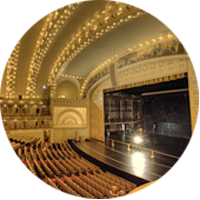
Architects: Adler and Sullivan
First Opened: 9th December 1889 (136 years ago)
Former Names: Auditorium Servicemen’s Center
Website: auditoriumtheatre.org 
Telephone: (312) 341-2310 
Address: 50 East Congress Pkwy, Chicago, IL 60605 
Completed in 1889, the Auditorium Theatre is part of a larger building complex in downtown Chicago called the Auditorium Building. The architects, Dankmar Adler and Louis Sullivan, with young draughtsman Frank Lloyd Wright, incorporated several modern features into the theatre such as air cooling and 3,500 electric lamps.

 Detailed Information
Detailed Information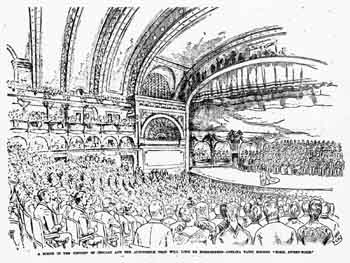
At the time of its design, philanthropist Ferdinand Wythe Peck envisioned what was perhaps the first mixed-use building in modern times: a theatre, hotel, and offices all in one coordinated building with receipts from the hotel and offices helping to subsidize the theatre.
Peck wanted to replace Chicago’s aging music hall with an opera house to rival anything found in New York. His vision of the Auditorium Theatre being a meeting place for the working man and the well-to-do was carried over into Adler & Sullivan’s design which saw the expensive box seats moved to the sides at 90 degrees to the stage, affording clear views for the four levels of cheaper seats.
The architectural style of the theatre has been dubbed Richardsonian Romanesque, named for Henry Hobson Richardson (1838-1886), and is a revival style based on French and Spanish Romanesque precedents of the 11th century. Richardson’s style is characterized by massive rough cut stone walls and dramatic semicircular arches, deeply recessed windows, and a new dynamism of interior space. Continuity and unity are keynotes of Richardson’s style.
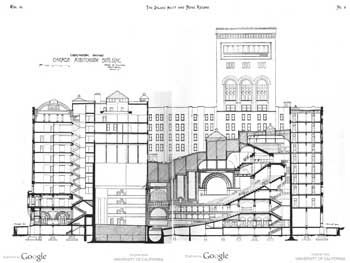
The Auditorium has a ceiling that gradually heightens as it recedes in several arches, a design unprecedented in the late 19th century. It was the first theatre to be shaped like the horn of a trumpet.
The 3,500 incandescent electric lamps (originally carbon filament) which run along the ceiling arches and the fronts of the balcony and galleries envelope the audience and eliminate the need for a conventional chandelier in the center of a domed ceiling, common feature in most 19th century opera houses and almost certain to deaden a hall’s acoustics.
Mosaic marble floors flow throughout the theatre. In all, Sullivan used 55 million pieces of mosaic tile. Over the doors at the building’s entrance are six arched art glass lunettes inspired by the allegorical figures of Wisdom, Oratory, Drama, Music, Poetry, and Dance.
Once built, the Auditorium Building was Chicago’s tallest with its 17-story tower, and its largest given the footprint of half a city block. Air throughout the building was cooled using up to 15 tons of ice per day. Built upon marshland, the foundations were essentially a raft of steel, wood, concrete, and pitch, and the 110,000 ton building settled about three feet lower than the foundations were originally set, resulting in several steps down from street level to the box office and the slightly listing floor in the theatre’s main lobby.
The hotel gradually fell out of favor as patrons developed a preference for private bathrooms instead of the shared bathrooms offered at the Auditorium Building.
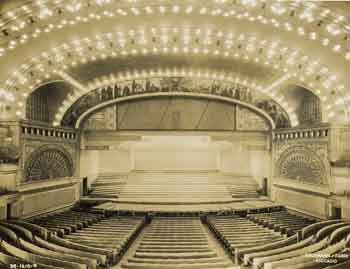
In 1904 the Chicago Symphony Orchestra moved out of the theatre to its own building (Orchestra Hall, now called Symphony Center), and in 1929 the Grand Opera followed suit (moving to the newly built Civic Opera House), leaving the theatre with no permanent tenant. Steel frame skyscrapers soon eclipsed the Auditorium’s stone built office tower. By the early 1930s estimates for demolition were being requested however they were all more costly than the land was worth. In 1941 the theatre declared bankruptcy and was closed.
During World War II the city commandeered the theatre for use as the Auditorium Servicemen’s Center (a USO center) for feeding and entertainment, which included converting part of the theatre into a bowling alley.
In 1946 Roosevelt University acquired the building, and although they used the hotel and office space, the theatre remained shuttered. In the early 1960s, Roosevelt University trustee Beatrice Spachner created the Auditorium Theatre Council, raising $3 million to refurbish the theatre in a project overseen by architect Harry Weese. The theatre reopened in 1967 and has remained in use ever since.
The theatre has been home to all manner of events, from classical concerts and ballet to large scale Broadway productions including Les Misérables and The Phantom of the Opera, and rock concerts featuring artists such as Jimi Hendrix, The Who, Janis Joplin, The Doors, Elton John, The Grateful Dead, and many others.
The theatre as built had a capacity of 4,200. The auditorium is vast, however ingenious devices – part of the original design – allowed the theatre to appear smaller in size when needed: movable ceiling panels at the front of the Upper and Lower Galleries could be lowered to close off those spaces when not required. In addition, curtains were originally fitted to close off the rear sections of the Balcony. The net result was a reduction in seats from 4,200 to 2,500. At its current capacity of 3,901 the theatre is the second largest concert hall in the US, after the Metropolitan Opera House in New York.
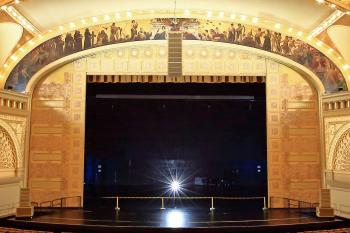
A “reducing curtain” was designed to alter the size of the proscenium arch. For large events the reducing curtain was flown out affording the full width of 75ft and a height of 40ft (22.9m by 12.2m). For smaller productions the reducing curtain was lowered, narrowing the proscenium opening to 47ft wide by 35ft high (14.3m by 10.7m). The solid reducing curtain’s panels are decorated with intricate designs and contain the names of ten famous composers.
There are two murals adorning the side walls of the auditorium, by Albert Fleury, which depict Spring (House Right) and Winter (House Left). In addition there is an allegorical mural by Charles Holloway running – unusually – from right to left along the top of the proscenium arch, intended to suggest the passage of time of a lifespan through music.
Originally 26 hydraulic lifts were installed under the theatre’s huge 100ft x 63ft (30.6m by 19.2m) stage. Those are now gone however the theatre still has three functioning lifts for varying sizes of Orchestra Pit. The stagehouse had a 95ft (29m) high Grid[iron] (now 80ft – 24.4m) allowing for the largest of scenic pieces, and all the evidence suggests the theatre was the recipient of the first counterweight flying system throughout all of North America. Other stage machinery included a rolling backdrop cyclorama, consisting of a 300ft long by 70ft high (91.4m by 21.3m) canvas roll arranged in a large half circle. Rarely for a theatre in the North America, a Thunder Run was installed when the theatre was built, and still exists.
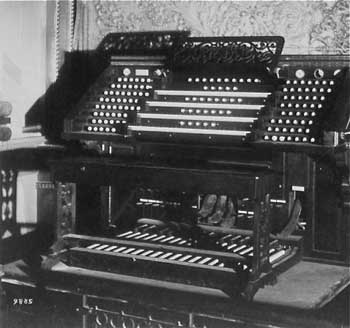
The Auditorium was originally equipped with an organ, “Frank Roosevelt No. 400”, which was a 4-manual, 127-rank (some sources report 129-rank) instrument, featuring imported reeds by French organ builder Aristide Cavaillé-Coll and reported to have cost around $50,000. The 7,193-pipe behemoth was officially dedicated on 29th October 1890. The organ chambers were located at the sides of the auditorium just in advance of the stage however are now sealed up. An echo organ was located within the dome above the Orchestra seating and a stage organ was installed within a swell box backstage, far enough up a wall to be out of the way.
In 1941/2, when the theatre was being converted into a USO center, the organ was sold at auction for $1,000 to William H. Barnes. Barnes initially stored the organ then donated it to Indiana University in 1944; the Aeolian-Skinner Organ Company installed it into the Indiana University Auditorium which is where it remains to this day.
The Joffrey Ballet has been resident at the Auditorium since 1998 however in late 2017 announced their intention to vacate the Auditorium and move to the Lyric Opera House by 2020. The Auditorium continues to play host to Chicago’s large scale musicals and live events, and recently enjoyed USA-wide publicity as home of the NFL Drafts in 2015 and 2016.
The Auditorium Theatre was named Outstanding Historic Theatre of 2019 by the League of Historic American Theatres  for its programs and services, its community impact, and the quality of its restoration and rehabilitation work.
for its programs and services, its community impact, and the quality of its restoration and rehabilitation work.
 Listed/Landmark Building Status
Listed/Landmark Building Status (15th September 1976)
(15th September 1976) (17th April 1970)
(17th April 1970) How do I visit the Auditorium Theatre?
How do I visit the Auditorium Theatre?Tours run regularly, cost $18, and last 80-90 minutes. For tour schedule and online ticketing check out the tour website  .
.
 Further Reading
Further Reading has a history and detailed timeline of the theatre, alongside a calendar of events and online booking.
has a history and detailed timeline of the theatre, alongside a calendar of events and online booking. contains further history and some additional photos.
contains further history and some additional photos. which contains detailed history and many historic photos/illustrations.
which contains detailed history and many historic photos/illustrations. .
. , played at opening night on the Auditorium Theatre’s organ. The document includes a diagram and specifications of the organ.
, played at opening night on the Auditorium Theatre’s organ. The document includes a diagram and specifications of the organ. .
. .
. .
. .
. .
. by Eric Allix Rogers
by Eric Allix Rogers  .
. by Konrad Schiecke, published by McFarland & Company. ISBN 0786465905.
by Konrad Schiecke, published by McFarland & Company. ISBN 0786465905. Technical Information
Technical Information Photos of the Auditorium Theatre
Photos of the Auditorium TheatrePhotographs copyright © 2002-2025 Mike Hume / Historic Theatre Photos unless otherwise noted.
Text copyright © 2017-2025 Mike Hume / Historic Theatre Photos.
For photograph licensing and/or re-use contact us here  . See our Sharing Guidelines here
. See our Sharing Guidelines here  .
.
| Follow Mike Hume’s Historic Theatre Photography: |  |
 |